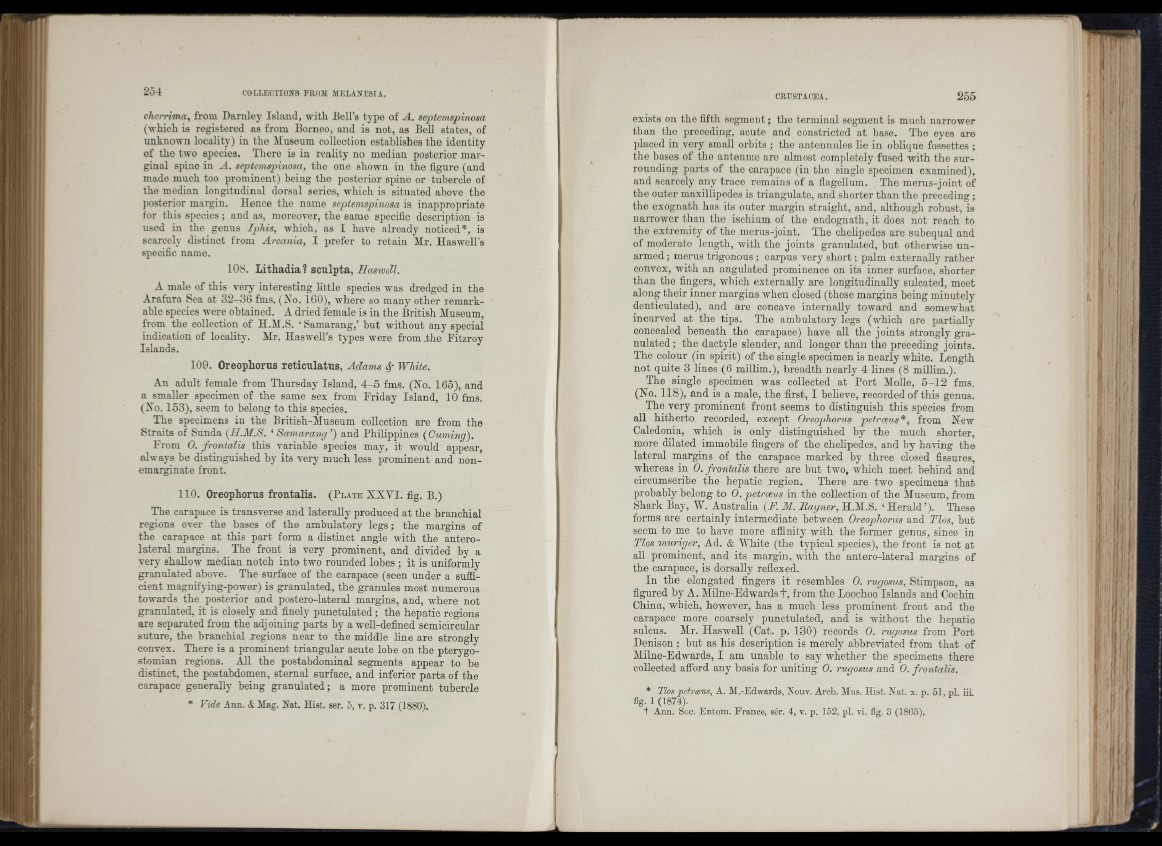
Hi I» .(te
■ '!‘5
’ i
ilf
F4
l l
il I
jf.Uil !'
|h '
H i
chcrrima, from Darulcy Island, with Rell’s type of A . seqitcmsqdnosa
(which is registered as from Borneo, and is not, as Bell states, of
unknown locality) in tlie Aluseum collection establishes tho identity
of the two species. There is iu reality no median posterior marginal
spine in A . seqitenisqniiosa, tho one shown in the figure (and
made much too prominent) being the posterior spine or tubercle of
the median longitudinal dorsal series, which is situated above the
})osterior margin. Hence the name sepiemsqrinosa is inappropriate
for this species; and as, moreover, the same specific description is
used in the genus IqJus, which, as I have already noticed*, is
scarcely distinct from Arcania, I prefer to retain Air. Haswell’s
specific name.
108. Lithadia? sculpta, Hasiuell.
A male of this very interesting little species was dredged in the
Arafura Sea at 32-36 fms. (No. 160), where so many other remarkable
species were ohtained. A dried female is in the British Museum,
from the collection of H.M.S. ‘ Samarang,’ bnt without any special
indication of locality. Mr. Haswell’s types were from .the Fitzroy
Islands.
109. Oreophorus reticulatus, Adams ¿j White.
An adult female from Thursday Island, 4 -5 fms. (No. 165), and
a smaller specimen of the same sex from Friday Island, 10 fms.
(No. 153), seem to belong to this species.
The specimens iu the British-Museum collection are from the
Straits of Sunda (H.M.S. ‘ Samarang’) and Philippines (Cuming).
From 0. frontalis this variable species may, it would appear,
always be distinguished by its very much less prominent and non-
emarginate front.
110. Oreophorus frontalis. (P late XXVI. fig. B.)
The carapace is transverse and lateraUy produced at the branchial
regions over the bases of the ambulatory legs; the margins of
the carapace at this part form a distinct angle with the anterolateral
margins. The front is very prominent, and divided by a
very shallow median notch into two rounded lobes ; it is uniformly
granulated above. The surface of the carapace (seen under a sufficient
magnifying-power) is granulated, the granules most numerous
towards the posterior and postero-lateral margins, and, where not
granulated, it is closely and finely punctulated; the hepatic regions
are separated from the adjoining parts by a well-defined semicircular
suture, the branchial regions near to the middle line are strongly
convex. There is a prominent triangular acute lobe on the pterygostomian
regions. AU the postahdominal segments appear to be
distinct, the postahdomen, sternal surface, and inferior parts of the
carapace generally being granulated; a more prominent tubercle
* Vide Ann. & Mag. Nat. Hist. ser. 5, v. p. 317 (1880).
exists on tho fifth scgmoiit; the terminal segment is much narrower
than tho preceding, acute and constricted at base. The eyes are
placed in very small orbits ; the antennules lie in oblique fossettcs ;
the bases of the antennae aro almost completely fused with the surrounding
parts of the carapace (in tho single specimen examined),
and scarcely any trace remains of a flagellum. The merus-joint of
the outer maxillipedes is triangulate, and shorter than the preceding ;
tho exognath has its outer margin straight, and, although robust, is
narrower than the ischium of the ondognath, it does not reach to
the extremity of tho merus-joint. The chelipedes are subequal and
of moderate length, with the joints granulated, but otherwise un armed
; merus trigonous; carpus very sh o rt; palm externally rather
convex, with an angulated prominence on its inner surface, shorter
than the fingers, which externally are longitudinally sulcated, meet
along their inner margins when closed (these margins being minutely
denticulated), and are concave internally toward and somewhat
incurved at the tips. The ambulatory legs (which are partially
concealed beneath the carapace) have all the joints strongly granulated
; tho dactyle slender, and longer than the preceding joints.
The colour (in spirit) of the single specimen is nearly white. Length
not quite 3 lines (6 millim.), breadth nearly 4 lines (8 millim.).
The single specimen was collected at Port Alolle, 5 -1 2 fms.
(No. 118), and is a male, the first, I believe, recorded of this genus.
The very prominent front seems to distinguish this species from
all hitherto recorded, except Oreoqlhorus petrceus*, from New
Caledonia, which is only distinguished by the much shorter,
more dilated immobile fingers of the chelipedes, and by having the
lateral margins of the carapace marked by three closed fissures,
whereas in 0. frontalis there are hnt two, which meet behind and
circumscribe the hepatic region. There are two specimens that
probably belong to 0. petrceus in the coUection of the Aluseum, from
Shark Bay, W. Australia (A. M. Bayner, H.Al.S. ‘ Herald ’). These
forms are certainly intermediate between Oreophorus and Tlos, but
seem to me to have more affinity with the former genus, since in
Tlos muriger. Ad. & AVhite (the typical species), the front is not at
all prominent, and its margin, with the antero-lateral margins of
the carapace, is dorsally reflexed.
In the elongated fingers it resembles 0. rugosus, Stimpson, as
figured by A. Milne-Edwards t , from the Loochoo Islands and Cochin
China, which, however, has a much less prominent front and the
carapace more coarsely punctulated, and is without the hepatic
sulcus. Air. Haswell (Cat. p. 130) records 0. rugosus from Port
Denison ; but as his description is merely abbreviated from th at of
Alilne-Edwards, I am unable to say whether the specimens there
collected afford any basis for uniting 0. rugosus aná 0. frontalis.
* Tlos petr(SUS, A. M.-Edwards, Nouv. Arch, AIus. Hist. Nat. x. p. 51, pi iiL
fig. 1 (1874).
t Ann. Soc. Entom. France, sér. 4, v. p. 152, pi. vi. fig. 3 (1865). I ; !
' I
!ü -
''' )
I ' 1